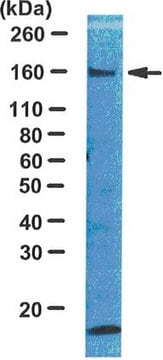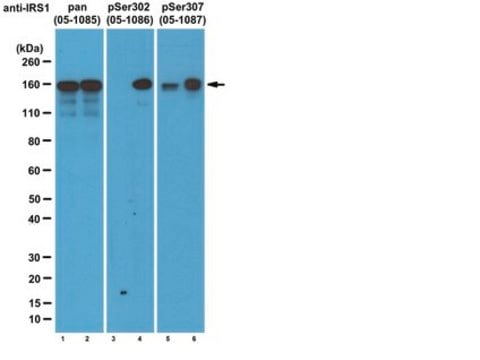05-784R
Anti-IRS1 Antibody, clone 58-10C-31, rabbit monoclonal
clone 58-10C-31, from rabbit
Synonyme(s) :
insulin receptor substrate 1
About This Item
Produits recommandés
Source biologique
rabbit
Niveau de qualité
Forme d'anticorps
purified immunoglobulin
Type de produit anticorps
primary antibodies
Clone
58-10C-31, monoclonal
Espèces réactives
human, rat, mouse
Technique(s)
immunoprecipitation (IP): suitable
western blot: suitable
Isotype
IgG
Numéro d'accès NCBI
Numéro d'accès UniProt
Conditions d'expédition
dry ice
Modification post-traductionnelle de la cible
unmodified
Informations sur le gène
human ... IRS1(3667)
Description générale
Spécificité
Immunogène
Application
Metabolism
Insulin/Energy Signaling
Immunoprecipitation Analysis: 1 µg from a previous lot immunoprecipitated IRS-1 from 100 µg of MCF7 cell lysate. Arrow indicates IRS-1 (~160 kDa). There is cross reactivity of the detection antibody with the heavy chaing of Rabbit IgG as shown at ~50 kDa.
Qualité
Western Blot Analysis: 0.1 µg/mL of this antibody detected IRS-1 on 10 µg of 3T3/A31, 3T3/L1, L6, or MCF7 cell lysates.
Description de la cible
Forme physique
Stockage et stabilité
Handling Recommendations: Upon receipt and prior to removing the cap, centrifuge the vial and gently mix the solution. Aliquot into microcentrifuge tubes and store at -20°C. Avoid repeated freeze/thaw cycles, which may damage IgG and affect product performance.
Note: Variability in freezer temperatures below -20°C may cause glycerol containing solutions to become frozen during storage.
Remarque sur l'analyse
3T3/A31, 3T3/L1, L6, or MCF7 cell lysates
Autres remarques
Clause de non-responsabilité
Not finding the right product?
Try our Outil de sélection de produits.
Code de la classe de stockage
12 - Non Combustible Liquids
Classe de danger pour l'eau (WGK)
WGK 1
Point d'éclair (°F)
Not applicable
Point d'éclair (°C)
Not applicable
Certificats d'analyse (COA)
Recherchez un Certificats d'analyse (COA) en saisissant le numéro de lot du produit. Les numéros de lot figurent sur l'étiquette du produit après les mots "Lot" ou "Batch".
Déjà en possession de ce produit ?
Retrouvez la documentation relative aux produits que vous avez récemment achetés dans la Bibliothèque de documents.
Notre équipe de scientifiques dispose d'une expérience dans tous les secteurs de la recherche, notamment en sciences de la vie, science des matériaux, synthèse chimique, chromatographie, analyse et dans de nombreux autres domaines..
Contacter notre Service technique








